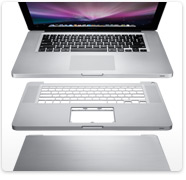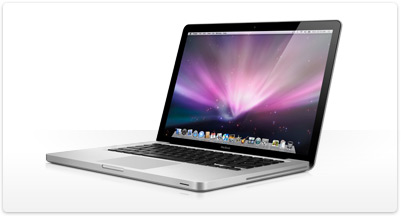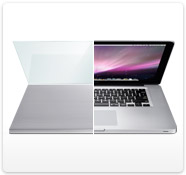
Redesigned. Reengineered. Re-everythinged.
To build something truly different, you need to work in a truly different way. Apple designers and engineers work together through every stage of product development. It’s a partnership that makes innovation possible. And it’s exactly how the new MacBook Pro was created. With its breakthrough unibody enclosure, industry-first features, and environmentally sound design, it’s a revolution in the way notebooks are made.
Until now, all notebooks were designed the same way. By assembling multiple pieces to create a single enclosure. But once you include all the necessary parts, you add size, weight, complexity, and more opportunities for failure. Solving a problem like this required more than an incremental change. It required a breakthrough. To create the new MacBook Pro, the design and engineering teams devised a way to replace many parts with just one. That one part is called the unibody — a seamless enclosure carved from a single piece of aluminium.

Unibody Enclosure
The new MacBook Pro starts life as a single piece of aluminium.
Of course, building only one part creates its own set of challenges. When you have multiple parts that are fastened together, tolerances don’t need to be perfect. You have wiggle room, both literally and figuratively. But when one part is responsible for many functions, it’s critical to manufacture that part with absolute precision, down to the micron. Every time. Millions of times over. There was only one way to achieve this level of precision: mill the unibody from a solid block of aluminium using computer numerical control, or CNC, machines — the kind used by the aerospace industry to build mission-critical spacecraft components.
When you pick up a new MacBook Pro, you immediately notice the difference. The entire enclosure is thinner and lighter. It looks polished and refined. And it feels strong and durable — perfect for life inside (and outside) your briefcase or backpack.

Interactive Gallery
Explore all the design innovations of the new MacBook Pro.

The thickness of a notebook display depends on the technology inside. LCD displays typically use cold cathode fluorescent lamps, or CCFLs, to create light and project a picture onto a screen. But that poses two problems. First, these lamps require more space, so the display can be only so thin. Second, just like the fluorescent lights in your home or office, the ones inside a CCFL display take time to warm up before they reach full brightness. That’s a lose-lose situation. And it’s why Apple engineers chose LED backlight technology for the new MacBook Pro.
An LED backlight creates the same amount of brightness in less space. So you can make the structure that houses an LED display much thinner. And unlike fluorescent lamps, an LED backlight reaches maximum brightness instantly.
Look at the MacBook Pro display and you’ll see another big difference. Glass. That edge-to-edge, uninterrupted glass display does more than look good. It also adds structure to the LED display beneath it. And there’s no metal frame (another extraneous part) to distract you from what’s onscreen.

Multi-Touch Trackpad
The spacious glass trackpad is also a button.
The new MacBook Pro trackpad has no button because it is the button. That means there’s more room to track, more room to click — left, right, centre, and everywhere in between — and one less part. Apple designers and engineers spent countless hours considering things like sensitivity (how much pressure triggers a click?), audio feedback (what does the click sound like?), and friction over the smooth glass surface (what does it feel like?).
And that’s just the hardware. Apple software engineers had a large part to play in the development of the trackpad, too. They incorporated Multi-Touch gestures, including swipe, pinch, rotate, and the new four-finger swipe. The result is the largest, smartest, most ergonomic MacBook Pro trackpad ever. It’s one of many details considered and reconsidered during the design process.
There’s a story behind each part. Take the thumbscoop, for example. It’s the indentation that allows you to open the display. If the scoop is too deep, you put too much pressure on the display to open it. If it’s too shallow, you struggle to open the display. It may seem incidental, but if the thumbscoop is well designed, it makes the difference between a bad experience and a good one. The challenge of the thumbscoop was to create a crisply machined scoop that was still comfortable to use. The designers at Apple worked on hundreds of versions of the thumbscoop — even examining them under an electron microscope — to get it right.

Then there’s the sleep indicator light. An indicator is functional only when it’s indicating something. Look to the right of the thumbscoop. You see nothing. Until you close the display and your MacBook Pro goes to sleep. Then an LED glow appears from inside the enclosure. How? During the CNC process, a machine first thins out the aluminium. Then a laser drill creates small perforations for the LED light to shine through. These holes are so tiny that the aluminium appears seamless when the light is off.
The marriage of electronics and mechanical design makes the new MacBook Pro as advanced on the inside as it is on the outside. The internal architecture has been reengineered from the silicon up. There’s a new logic board. A new chipset. And a new graphics architecture — a feat of engineering in itself.
Many notebook computers sacrifice graphics performance in order to save battery life. The new MacBook Pro offers the best of both worlds, thanks to not one, but two separate graphics processors.
The GeForce 9600M GT processor is the discrete graphics powerhouse. The GeForce 9400M processor is the integrated power saver. And depending on how much performance or battery life you need, you can switch between them easily.
Because Apple designs both the hardware and the software for the new MacBook Pro, it’s easier to improve things like energy efficiency. Software tells the hard drive to spin down when it’s not in use. It tells the display and battery indicator lights to dim in low-light conditions. And it helps decide whether the CPU or the graphics processor would be best suited to the task at hand. That’s the kind of smart, integrated design that sets MacBook Pro apart from other notebooks.

A Greener Notebook
Made from recyclable aluminium and glass, the new MacBook Pro is greener than ever.
Top-to-bottom integration also makes MacBook Pro greener than other notebooks. Complete control over how the new MacBook Pro is designed, how it’s manufactured, and how it’s packaged gives Apple an environmental edge. Take the MacBook Pro display, for instance. Conventional CCFL displays use mercury to create a backlight and arsenic to prevent irregularities in the glass. The LED-backlit display on the new MacBook Pro, on the other hand, is both mercury- and arsenic-free. LED backlight technology also conserves energy: This display requires 30 percent less power than a CCFL display.
Mercury and arsenic aren’t the only toxins absent from the new MacBook Pro. Many computer manufacturers have only pledged to eliminate polyvinyl chloride (PVC) and brominated flame retardants (BFRs) from their enclosures and circuit boards. Apple is removing not only PVC and BFRs, but all forms of bromine and chlorine throughout the entire MacBook Pro.
Just how green is the new MacBook Pro? It’s ENERGY STAR compliant, which means it meets the government standard for energy efficiency. It’s also earned EPEAT Gold status, the highest standard for environmental performance in the electronics industry. And every new MacBook Pro is shipped in packaging that’s 37 percent smaller than any previous generation. That translates to fewer trees used for boxes and less fuel used to transport more MacBook Pros on fewer planes. And at the end of its long, productive life, you can recycle almost all of your MacBook Pro.
Only Apple could make a notebook like this. Hardware and software. Design and engineering. Production and manufacturing. They’re all part of a single process at Apple. When you start using your new MacBook Pro, you’ll discover what that means. The light and sturdy unibody protects the components inside. The LED-backlit display — along with the graphics processor that helps power it — gives you faster games and a brilliant canvas for your photos, movies, and more. The glass Multi-Touch trackpad feels as good as it functions. From the smallest detail to the biggest engineering breakthrough, the new MacBook Pro truly is the next generation of notebooks.














